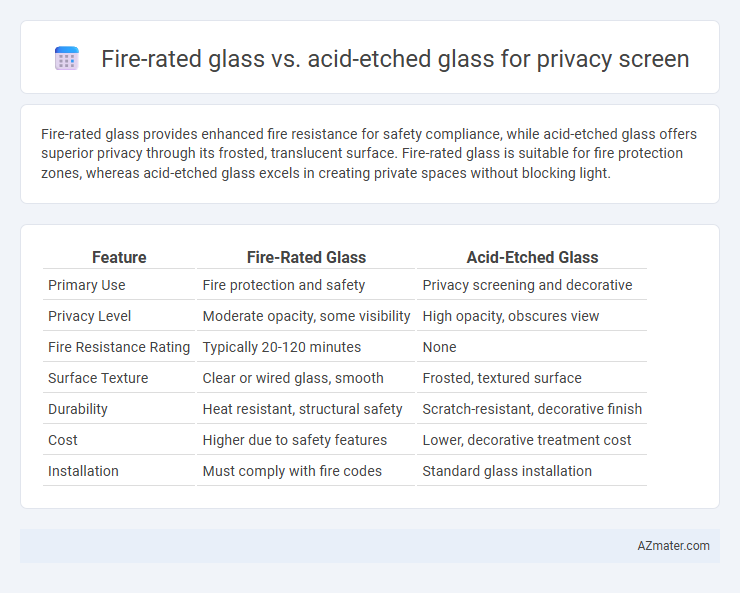Fire-rated glass provides enhanced fire resistance for safety compliance, while acid-etched glass offers superior privacy through its frosted, translucent surface. Fire-rated glass is suitable for fire protection zones, whereas acid-etched glass excels in creating private spaces without blocking light.
Table of Comparison
| Feature | Fire-Rated Glass | Acid-Etched Glass |
|---|---|---|
| Primary Use | Fire protection and safety | Privacy screening and decorative |
| Privacy Level | Moderate opacity, some visibility | High opacity, obscures view |
| Fire Resistance Rating | Typically 20-120 minutes | None |
| Surface Texture | Clear or wired glass, smooth | Frosted, textured surface |
| Durability | Heat resistant, structural safety | Scratch-resistant, decorative finish |
| Cost | Higher due to safety features | Lower, decorative treatment cost |
| Installation | Must comply with fire codes | Standard glass installation |
Introduction to Fire-Rated and Acid-Etched Glass
Fire-rated glass is specially designed to withstand high temperatures and prevent the spread of flames and smoke during a fire, making it essential for safety in commercial and residential buildings. Acid-etched glass features a frosted surface created by chemically treating the glass with acid, providing a high level of privacy by obscuring visibility while maintaining natural light transmission. Both materials serve distinct purposes for privacy screens: fire-rated glass prioritizes safety and compliance with fire codes, whereas acid-etched glass emphasizes aesthetic appeal and visual privacy.
Understanding Privacy Needs in Architecture
Fire-rated glass provides essential safety by preventing fire spread while maintaining visibility, making it ideal for areas requiring both privacy and adherence to building codes. Acid-etched glass offers enhanced privacy through its frosted, translucent surface that obscures vision without sacrificing natural light, commonly used in interior partitions and office screens. Understanding the balance between fire safety regulations and privacy requirements guides architects in selecting the appropriate glass type for functional and compliant design solutions.
Key Features of Fire-Rated Glass
Fire-rated glass provides exceptional resistance to heat and flames, ensuring safety and integrity during fire emergencies with temperature ratings typically ranging from 20 minutes to 120 minutes. It is engineered with multiple layers of tempered or laminated glass combined with intumescent interlayers that expand under heat to block fire and smoke. Unlike acid-etched glass, which is primarily designed for aesthetic privacy and light diffusion, fire-rated glass offers certified fire protection while maintaining visibility and natural light transmission.
Key Characteristics of Acid-Etched Glass
Acid-etched glass provides a distinctive frosted appearance with a smooth, matte finish achieved through controlled chemical treatment, ensuring uniform texture and enhanced privacy by diffusing light without compromising brightness. It offers excellent customization options for patterns and designs, maintaining durability and resistance to scratches compared to traditional sandblasted finishes. Unlike fire-rated glass, acid-etched glass does not provide fire resistance but excels in aesthetic appeal and consistent opacity for privacy screens.
Privacy Performance: Fire-Rated Glass vs Acid-Etched Glass
Fire-rated glass offers moderate privacy by incorporating wired or ceramic interlayers that obscure visibility while maintaining fire resistance up to specific time ratings, typically 45 to 90 minutes. Acid-etched glass delivers superior privacy performance through a fully frosted surface that diffuses light and prevents clear visibility but lacks fire-resistance capabilities. For applications requiring both fire safety and privacy, fire-rated glass provides a balanced solution, whereas acid-etched glass is optimal for non-fire-rated environments prioritizing maximum visual privacy.
Safety and Fire Protection Considerations
Fire-rated glass provides superior safety by withstanding high temperatures and preventing the spread of flames and smoke, making it ideal for privacy screens in fire-critical areas. Acid-etched glass enhances privacy through surface texture but lacks fire resistance and does not contribute to fire protection measures. Choosing fire-rated glass ensures compliance with fire safety codes while maintaining privacy, whereas acid-etched glass prioritizes aesthetics without fire protection benefits.
Aesthetic and Design Flexibility
Fire-rated glass offers a sleek, transparent aesthetic with the added benefit of safety compliance, making it ideal for modern, minimalist privacy screens where visibility and protection are crucial. Acid-etched glass provides a frosted, opaque finish that enhances privacy while allowing soft, diffused light, perfect for creating stylish and customizable patterns or textures. Both materials deliver distinct design flexibility: fire-rated glass supports clear sightlines and fire safety, whereas acid-etched glass offers versatile decorative options and subtle visual separation.
Durability and Maintenance Comparison
Fire-rated glass offers exceptional durability due to its ability to withstand high temperatures and impacts, making it ideal for safety-critical privacy screens in commercial settings. Acid-etched glass provides a softer, decorative finish with moderate durability but requires more frequent cleaning to maintain its matte appearance, as it can accumulate dirt and smudges more easily. Maintenance for fire-rated glass is minimal and focused on inspecting seals and integrity, whereas acid-etched glass demands regular cleaning with non-abrasive agents to preserve its texture and clarity.
Cost Implications and Budget Factors
Fire-rated glass typically involves higher costs due to its specialized manufacturing and certification processes designed to withstand high temperatures and prevent fire spread. Acid-etched glass is more budget-friendly, offering privacy through a textured, frosted appearance without the added expense of fire-resistant properties. Choosing between the two depends on whether fire safety compliance is mandatory, as acid-etched glass suits standard privacy needs while fire-rated glass addresses stringent building codes and insurance requirements.
Choosing the Right Glass for Privacy Screens
Fire-rated glass offers robust safety by resisting heat and flames for up to 120 minutes, making it ideal for privacy screens in commercial buildings requiring fire compliance. Acid-etched glass enhances privacy through a frosted, translucent finish while allowing natural light to pass, suitable for office partitions and residential spaces without fire safety demands. Selecting the right glass depends on balancing fire safety standards with desired light diffusion and privacy levels in the specific environment.

Infographic: Fire-rated glass vs Acid-etched glass for Privacy screen
 azmater.com
azmater.com